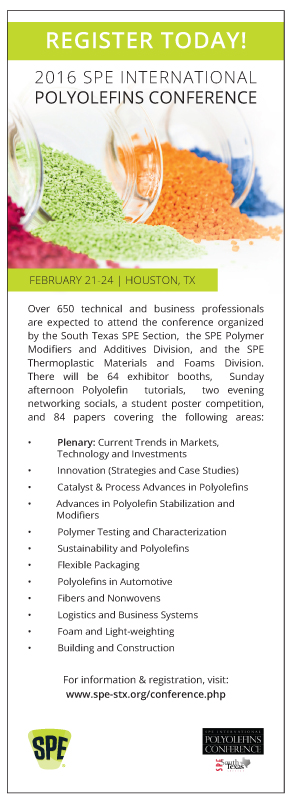GPS 2015 Hits a Home Run in Chicago with 4-D Printing and Walmart’s “Made in America” Campaign
Economists discuss the impact of China across the U.S. and world markets
Previous Article Next Article
By Kimberly Coghill
SPI Communications Director
GPS 2015 Hits a Home Run in Chicago with 4-D Printing and Walmart’s “Made in America” Campaign
Economists discuss the impact of China across the U.S. and world markets
Previous Article Next Article
By Kimberly Coghill
SPI Communications Director
GPS 2015 Hits a Home Run in Chicago with 4-D Printing and Walmart’s “Made in America” Campaign
Economists discuss the impact of China across the U.S. and world markets
Previous Article Next Article
By Kimberly Coghill
SPI Communications Director

Kimberly Coghill
China is still the elephant in the room. Whether the topic is labor, supply and demand, or economic growth, it seems like the China-effect is at the center of conversation. In opening remarks at the Global Plastics Summit 2015 (GPS), IHS chief economist Nariman Behravesh helped attendees put China in perspective; less than 1% of U.S. GDP is exported to China. Therefore, China doesn’t have the same impact on the U.S. economy as it does on the rest of the world.
The big hemorrhage in China is its mining and heavy manufacturing sectors, said Behravesh, indicating that the two sectors are experiencing a recession, compared to China’s booming service sector. But, China’s Achilles heel is not unlike the USA’s, or many other countries’—a dwindling workforce. And while China announced its decision to relax its one-child policy, Behravesh said the damage is done and China will not be able to sustain growth.
A Dwindling Workforce
A common theme throughout GPS was the looming threat of fewer skilled workers to take positions being vacated by Baby Boomers. Every society needs a healthy workforce not only to create goods and services, but also to consume them, said demographics expert Ken Gronbach.
So for China and other industrialized countries, a solution requires more than procreation. The next generation needs to be taught that innovative plastic products are necessary and that they are safe.
Getting Past the Negatives
But the industry must overcome negativity associated with manufacturing and plastics. Consider that the bulk of GPS’s presentations focused on markets and trends for associated materials like polyethylene, polypropylene, and others. After delivering a presentation on materials, Paul Caprio, president of KraussMaffei Corp., gleefully pointed out that “plastics professionals are the only people who appreciate and can get excited about these materials.” Outside of our industry, “plastic is a dirty word and it’s a huge challenge for us to change this,” he said.
Indeed it is, Gronbach cautioned: “If you don’t deal with public opinion, it will deal with you. The largest generation of people ever born are currently 11 to 30 years old, and they think all the time, and they are coming straight for you.”
So What Do We Do?
In addition to telling the positive stories about plastic, perhaps one solution is to sell tomorrow’s professionals on cutting-edge technology like 4-D printing. Massachusetts Institute of Technology (MIT) researcher Skylar Tibbits led a lively discussion about the future of plastics, noting “we use plastics in almost everything we do.”
Tibbits and his team at MIT have been working to develop the next generation of printing, called 4-D printing. What’s fascinating about 4-D printing is that it results in a transformative product like a robot that has the ability to solve problems. Through the use of 4-D printing, future products (think dental and medical devices) will be resilient and change with humans and the environment.
The consensus at GPS was that the USA needs advanced manufacturing such as 4-D printing.
If It’s Not the China-Effect, It’s the Walmart-Effect
Representing the brand-owner angle, Chris Quinn, president and CEO of the Step2 Company, mentioned Walmart’s celebrated move to buy $50 billion in U.S.-made products over the next ten years. “We now have a case to drive more manufacturing back to the U.S.,” he said, indicating that Walmart’s campaign will undoubtedly influence others to make similar declarations.
For the international community, there’s implied quality in U.S.-produced goods. And from the standpoint of the manufacturer, there are multiple benefits to operating in the USA, such as the protection of intellectual property, internet security benefits, and better control over transportation costs and logistics.
“After all, who wants to be in the footwear business when the port of [Los Angeles] shuts down[1] two months before school starts?” Quinn asked. “Not me. Transporting from Odessa [Texas] to Mobile [Alabama] is better.”
Reference
1. Khouri, A. “Line of ships waiting off coast grows as ports shut down for holiday,” Los Angeles Times, www.latimes.com/business/la-fi-port-dispute-20150216-story.html, Feb. 16, 2015.
For additional information or pictures from GPS 2015, contact Kimberly Coghill at kcoghill@plasticsindustry.org.
